Our universal interface plate allows easy configuration of most any I/O signal to the inside of the test enclosure. One enclosure may be tasked with different tests requiring different connectors and is easily changed in the field by simply replacing the interface plate.
Shown below are just a few of the filtered interfaces and connectors available for JRE Test chambers.

JRE offers a wide variety of RF connectors, each with attached dust cap. Generally connectors are bulkhead style meaning a Female connector style appearing on each side of the interface plate.
DC/AC Power Terminal Strips (Link here)
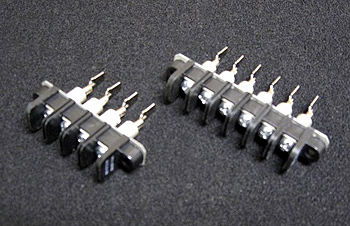
4 Terminal and 6 Terminal Barrier Strip - with 2500 pf feedthru filtering, 100 VDC/250VAC @ 20A. Use these heavy duty barrier terminal strips to allow RF filtered entry into the enclosure for AC or DC power.
USB 2.0 Serial Data Filtered Interfaces
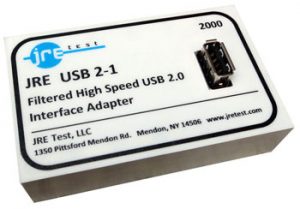
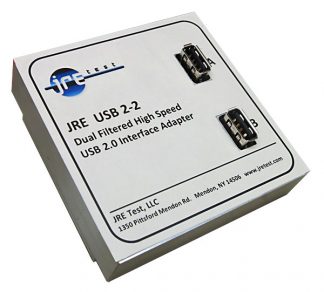
JRE offers two USB 2.0 Speed filtered interfaces. The JRE USB 2-1 is a single channel filter that is designed to reject frequencies greater than 880 MHz while passing data and power between a host computer on one side and a USB device on the other. Standard USB Type A connectors are used on each side of the filtered adapter. Fully USB compliant, correct enumeration process ensures any test ‘hiccups’ will be properly exchanged between devices, i.e.: no hang-ups are undetected, a problem when using fiber optic or other such interfaces! The filtered interface consists of a balanced pair of bi-directional data lines and a balanced power and return pair. The dual channel version of the filter consists of two sets of high speed USB 2.0 ports. Each port is terminated in an output cable that is 4 inches (minimum) long. The USB cable and connectors have the standard USB 2.0 pinout and configuration. The data line filters pass the up to 480Mbps of USB Type 1 or 2 data while providing rejection greater than 80dB from 1GHz through 6 GHz. The power line filters pass the DC power and return while providing rejection greater than 80dB from 1MHz through 6 GHz.
USB 3.0 'SuperSpeed' Serial Data Filtered Interfaces
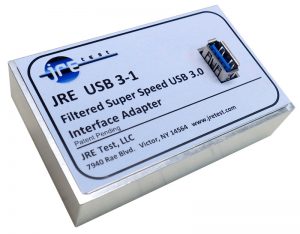
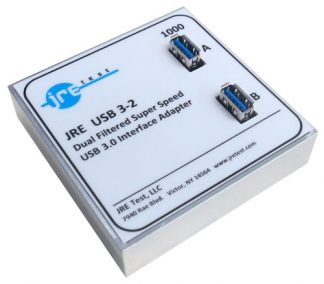
For USB 3.0 'SuperSpeed' applications, JRE offers two models, single and dual channel. The JRE USB 3.0 'SuperSpeed' data filter operates on an entirely new principle in data signal filtering. Previous filter designs used low pass filtering on the data lines to attenuate interfering wireless RF signals - however, as data speeds have increased, the data signals fall within the same frequency range as the interfering signals. Thus, simple low pass filtering cannot be used since such a filter will attenuate both the data and the interference!
Our Patent Pending design uses an innovative application of signal phasing techniques and topology to filter out all RF signals except for the desired data signals. This ability to discriminate between data signals and undesired RF signals is especially valuable when testing at USB Super Speed data rates (since the signaling rate falls within Wireless signal frequencies), or when testing devices where the potential RF interfering frequencies fall within the pass band of a low pass filtered USB interface (such as wireless keyfobs or RFID devices).
LAN-1 RJ-45 Ethernet 10/100/1000 Filtered Interface
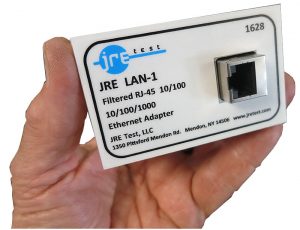
The JRE LAN-1 Filter consists of a 10/100/1000 Ethernet compliant low pass filter inside a machined aluminum housing which provides exceptional RF shielding on all 8 signal lines, making it compatible with standard Ethernet as well as any other format using an RJ-45 connector. The filter is designed to reject frequencies greater than the Cellular frequencies of 700 MHz while passing data between RJ-45 connected devices such as routers, switches, access points or other Ethernet devices.
Serial Data Connectors
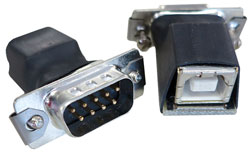
USB to DB-9 Adapter Set
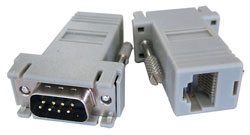
RJ-45 to DB-9 Adapter Set
These serial data connectors are simple adapters without any RF filtering and are to be used with the customer's choice of filtered DB-9 connector. In some cases enough filtering can be achieved using these simple adapters and a suitable filtered DB-9 connector. Each adapter set consists of two pieces: the USB style has DB-9M to USB type A and a DB-9F to USB type B, and the RJ-45 set has a pair of DB-9 to RJ-45 female. Various capacitance's are available in the DB connector for best trade-off between serial data speed and RF frequency attenuation. JRE Test stocks three values of filtered DB connectors that will pass various data rates. A capacitance of 1000 pf is used for data rates speeds up to 10 MBPS, 310 pf for speeds up to 50 MBPS, 100 pf for speeds up to 100 MBPS, and 10 pf for speeds up to 1000 MBPS. Higher capacitance filter networks provide higher levels of shielding effectiveness, at the expense of slowing the data speeds, while lower capacitance allows faster data speed but poorer RF isolation.
It is not recommended to use these adapters and filtered DB connectors for high speed data signal filtering of USB, Ethernet, or HDMI signals. One must have an extensive understanding of the limitations of capacitive loading of these data signals in order to use them properly, it is highly recommended to use a specially designed JRE Test filtered interface for signals other than low speed serial data. JRE Test offers the industry's broadest line of compliant data filters for a variety of signals. For true USB 3.0 and 2.0 speeds, JRE offers the industry's only USB 3.0 filtered interface, available in single and dual channel configuration, as well as USB 2.0 filters (see above). For Ethernet connectivity, the JRE LAN-1 and LAN-10G Ethernet filtered interfaces are the industry's lowest cost filters that allow excellent isolation while still passing 10/100/1000 and 10G Ethernet signals (see above).
DB Series Connectors
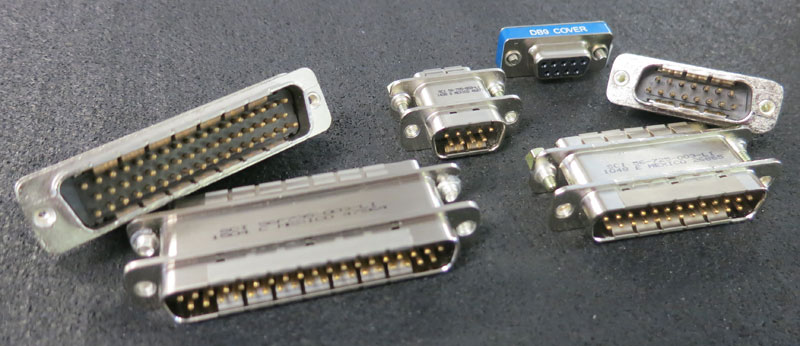
These filtered DB style connectors are used for general serial I/O into the enclosure, they may be used alone or in conjunction with adapters to meet most any connector style needed. JRE Test stocks three values of filtered DB connectors that will pass various data rates. A capacitance of 1000 pf is used for data rates speeds up to 10 MBPS, 310 pf for speeds up to 50 MBPS, 100 pf for speeds up to 100 MBPS, and 10 pf for speeds up to 1000 MBPS. Higher capacitance filter networks provide higher levels of shielding effectiveness, at the expense of slowing the data speeds, while lower capacitance allows faster data speed but poorer RF isolation.
AC Mains Power Strips (Link here)

4 Outlet USA

5 Outlet USA

6 Outlet USA
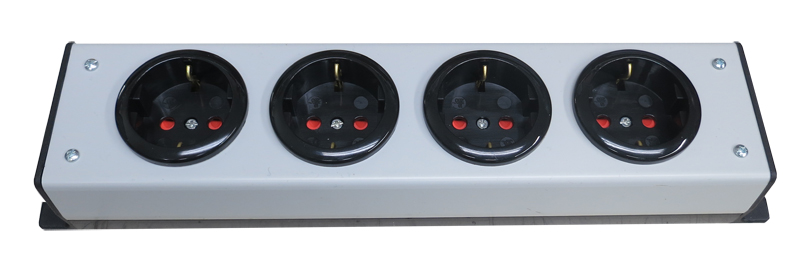
4 Outlet European Schuko
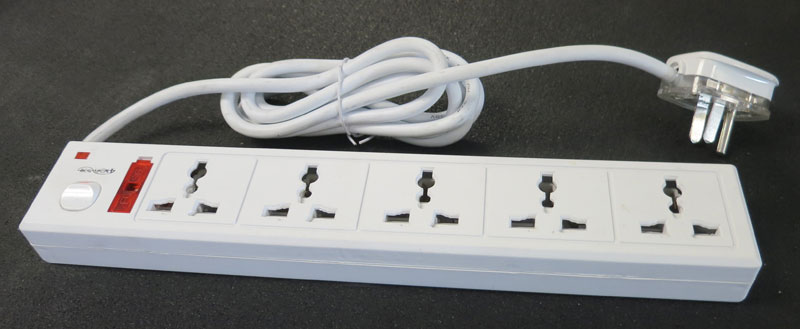
5 Outlet Universal

6 Outlet European Schuko
Fiber Optic Connectors

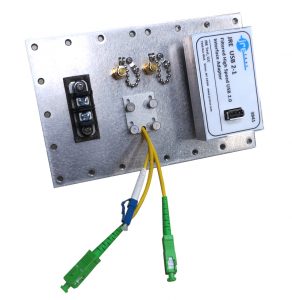

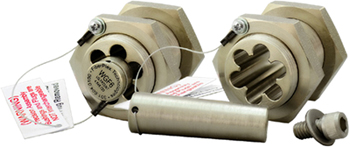
FC Simplex (L), ST Multimode (R) and Fiber 'Pass through' connectors
Fiber optic connector I/O offers the ultimate in RF shielding as there is no ohmic connection, only light. These connectors allows easy passing through of fiber optic cables with their connectors attached, making connections easy with no need to attach connectors in the lab or field. For operation up to 6 GHz, the JRE FPT can fit up to 5 fiber optic cables through its removable machined plate. The slotted opening is adjustable to allow secure fit of the cables and the ability to control the portal's size if fewer cables are used.
For operation at microwave frequencies up to 28 GHz, the unique Fiberplex WGF-6 'Pass through' should be used. Easy to use, the Allen head screw is removed and the center metal insert is removed. The fiber cable and connector are simply passed through the center. After the cable is passed through, the center metal insert is placed back in and the Allen screw is tighten. Note that up to six cables can be passed through. The precise machining of the device allows excellent shielding isolation all the way into the microwave region, providing over 60 dB at 25 GHz and well over 100 dB below 10 GHz.

